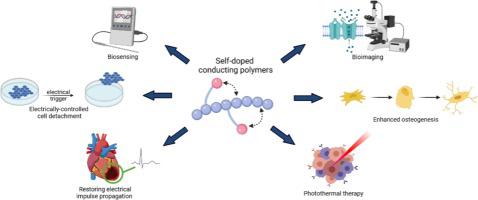Bioelectrochemistry ( IF 4.8 ) Pub Date : 2022-04-01 , DOI: 10.1016/j.bioelechem.2022.108127 Ichiro Imae 1 , Katarzyna Krukiewicz 2

|
Recent studies willingly agree that conducting polymers (CPs) are attractive materials for biomedical engineering purposes, mainly because of their unique physicochemical characteristics combining electrical conductivity and high biocompatibility. Nevertheless, the applicability of CPs is restricted by their limited stability under physiological conditions, associated with a decrease in electrical conductivity upon dedoping. Accordingly, modifying chemical structure of CPs to exhibit a self-doping effect seems to be an appealing approach aimed to enhance their functionality. The aim of this review is to provide a current state-of-the-art in the research concerning self-doped CPs, particularly those with potential biomedical applications. After presenting a library of available structure modifications, we describe their physicochemical characteristics, focusing on achievable conductivities, electrochemical, optical and mechanical behaviour, as well as biological properties. To highlight high applicability of self-doped CPs in biomedical engineering, we elaborate on biomedical areas benefiting most from using this type of conducting materials.
中文翻译:

生物医学工程中的自掺杂导电聚合物:合成、表征、当前应用和前景
最近的研究同意导电聚合物 (CP) 是用于生物医学工程目的的有吸引力的材料,主要是因为它们结合了导电性和高生物相容性的独特物理化学特性。然而,CPs 的适用性受到其在生理条件下的有限稳定性的限制,这与去掺杂时电导率的降低有关。因此,改变 CP 的化学结构以表现出自掺杂效应似乎是一种旨在增强其功能的有吸引力的方法。本综述的目的是提供有关自掺杂 CP 研究的最新技术,特别是那些具有潜在生物医学应用的研究。在展示了一个可用的结构修改库之后,我们描述了它们的物理化学特性,重点是可实现的电导率、电化学、光学和机械行为,以及生物学特性。为了突出自掺杂 CP 在生物医学工程中的高度适用性,我们详细阐述了从使用此类导电材料中受益最多的生物医学领域。











































 京公网安备 11010802027423号
京公网安备 11010802027423号